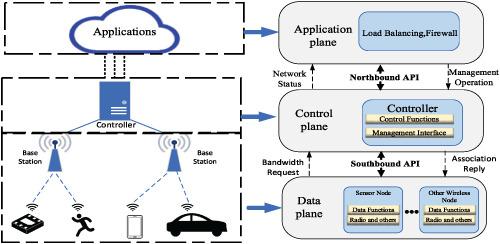当前位置:
X-MOL 学术
›
Int. J. Netw. Manag.
›
论文详情
Our official English website, www.x-mol.net, welcomes your feedback! (Note: you will need to create a separate account there.)
An efficient neural network optimized by fruit fly optimization algorithm for user equipment association in software‐defined wireless sensor network
International Journal of Network Management ( IF 1.5 ) Pub Date : 2020-08-11 , DOI: 10.1002/nem.2135 Xiao‐Ping Zeng 1, 2 , Qi Luo 1, 2 , Jia‐Li Zheng 1 , Guang‐Hui Chen 1, 2
International Journal of Network Management ( IF 1.5 ) Pub Date : 2020-08-11 , DOI: 10.1002/nem.2135 Xiao‐Ping Zeng 1, 2 , Qi Luo 1, 2 , Jia‐Li Zheng 1 , Guang‐Hui Chen 1, 2
Affiliation

|
Software‐defined wireless sensor network (SDWSN) has aroused great interest due to its new operating characteristics in recent years. For instance, centralized user association control, full network state information perception, and seamless switching. Furthermore, with the development of the Internet of things(IoT), all sensors and user equipment (UE) will be connected. The proposal of the Internet of everything concept has expanded the scope of SDWSN. It is a very challenging issue to ensure the quality of experience(QoE) while achieving load balancing when associating the UE and the base station (BS). Based on the new features of SDWSN, this paper studies a multi‐objective optimization model under multiple constraints in high‐density situations. The goal is to minimize the number of unsatisfied UEs and maximize system throughput by achieving load balancing. This problem was solved by employing an artificial neural network (ANN), which was optimized by the fruit fly optimization algorithm (FOA). This ANN–FOA scheme greatly reduced the execution time and significantly promoted the result of the multi‐objective optimization model. Through simulation, we verified the effectiveness of our proposed ANN–FOA scheme, and the influence of different sample quantity and different ANN architecture on the final result was explored.
中文翻译:

通过果蝇优化算法优化的高效神经网络,用于软件定义的无线传感器网络中的用户设备关联
近年来,软件定义的无线传感器网络(SDWSN)引起了人们的极大兴趣。例如,集中的用户关联控制,完整的网络状态信息感知和无缝切换。此外,随着物联网(IoT)的发展,所有传感器和用户设备(UE)将被连接起来。万物互联概念的提议扩大了SDWSN的范围。在关联UE和基站(BS)时,在实现负载平衡的同时确保体验质量(QoE)是一个非常具有挑战性的问题。基于SDWSN的新特性,本文研究了在高密度情况下多约束条件下的多目标优化模型。目标是通过实现负载平衡来最大程度地减少不满意的UE的数量,并最大化系统吞吐量。通过使用人工神经网络(ANN)解决了该问题,该人工神经网络已通过果蝇优化算法(FOA)进行了优化。这种ANN-FOA方案大大减少了执行时间,并大大提升了多目标优化模型的结果。通过仿真,我们验证了所提出的ANN-FOA方案的有效性,并探讨了不同样本数量和不同ANN体系结构对最终结果的影响。这种ANN-FOA方案大大减少了执行时间,并大大提升了多目标优化模型的结果。通过仿真,我们验证了所提出的ANN-FOA方案的有效性,并探讨了不同样本数量和不同ANN体系结构对最终结果的影响。这种ANN-FOA方案大大减少了执行时间,并大大提升了多目标优化模型的结果。通过仿真,我们验证了所提出的ANN-FOA方案的有效性,并探讨了不同样本数量和不同ANN体系结构对最终结果的影响。
更新日期:2020-08-11
中文翻译:

通过果蝇优化算法优化的高效神经网络,用于软件定义的无线传感器网络中的用户设备关联
近年来,软件定义的无线传感器网络(SDWSN)引起了人们的极大兴趣。例如,集中的用户关联控制,完整的网络状态信息感知和无缝切换。此外,随着物联网(IoT)的发展,所有传感器和用户设备(UE)将被连接起来。万物互联概念的提议扩大了SDWSN的范围。在关联UE和基站(BS)时,在实现负载平衡的同时确保体验质量(QoE)是一个非常具有挑战性的问题。基于SDWSN的新特性,本文研究了在高密度情况下多约束条件下的多目标优化模型。目标是通过实现负载平衡来最大程度地减少不满意的UE的数量,并最大化系统吞吐量。通过使用人工神经网络(ANN)解决了该问题,该人工神经网络已通过果蝇优化算法(FOA)进行了优化。这种ANN-FOA方案大大减少了执行时间,并大大提升了多目标优化模型的结果。通过仿真,我们验证了所提出的ANN-FOA方案的有效性,并探讨了不同样本数量和不同ANN体系结构对最终结果的影响。这种ANN-FOA方案大大减少了执行时间,并大大提升了多目标优化模型的结果。通过仿真,我们验证了所提出的ANN-FOA方案的有效性,并探讨了不同样本数量和不同ANN体系结构对最终结果的影响。这种ANN-FOA方案大大减少了执行时间,并大大提升了多目标优化模型的结果。通过仿真,我们验证了所提出的ANN-FOA方案的有效性,并探讨了不同样本数量和不同ANN体系结构对最终结果的影响。



























 京公网安备 11010802027423号
京公网安备 11010802027423号